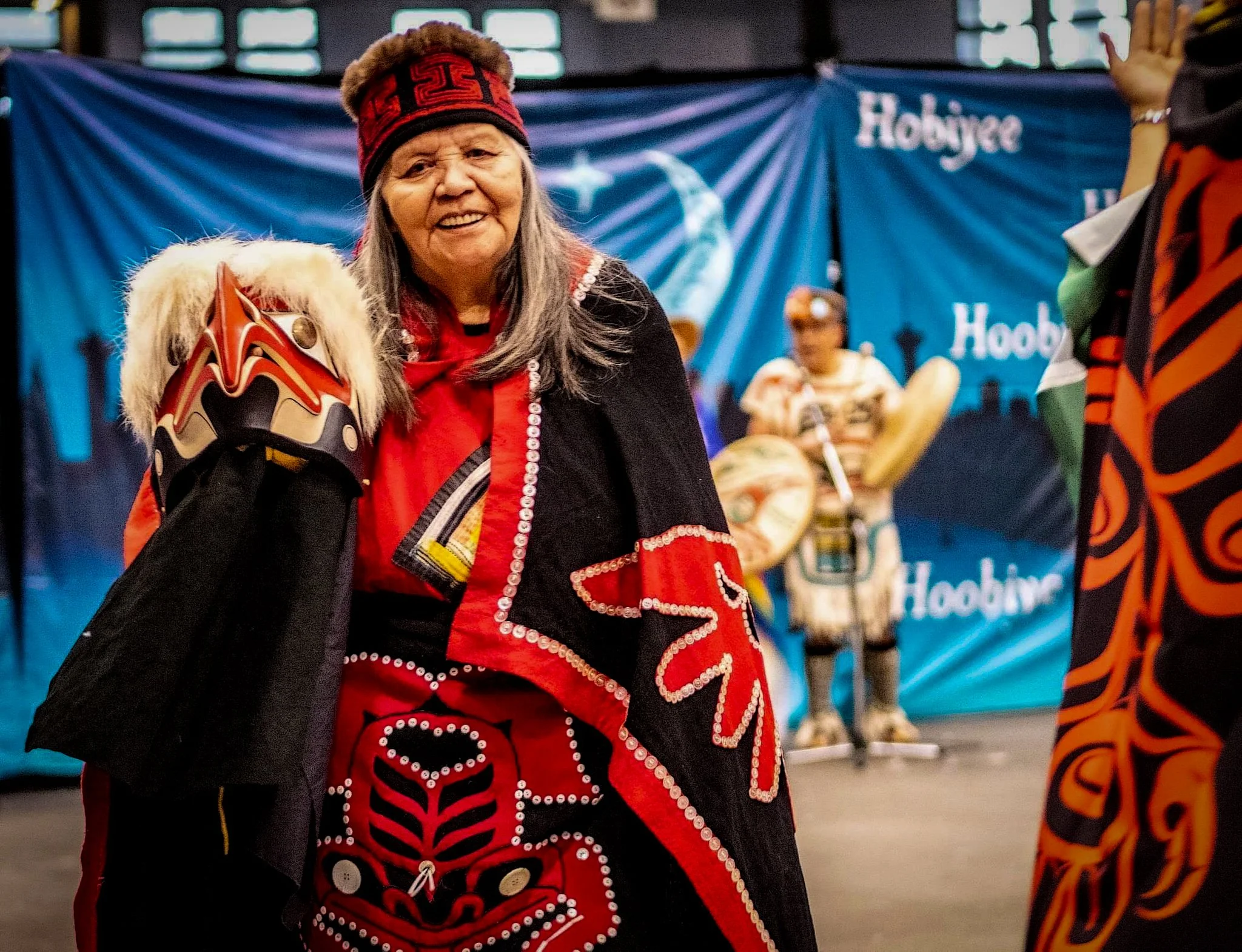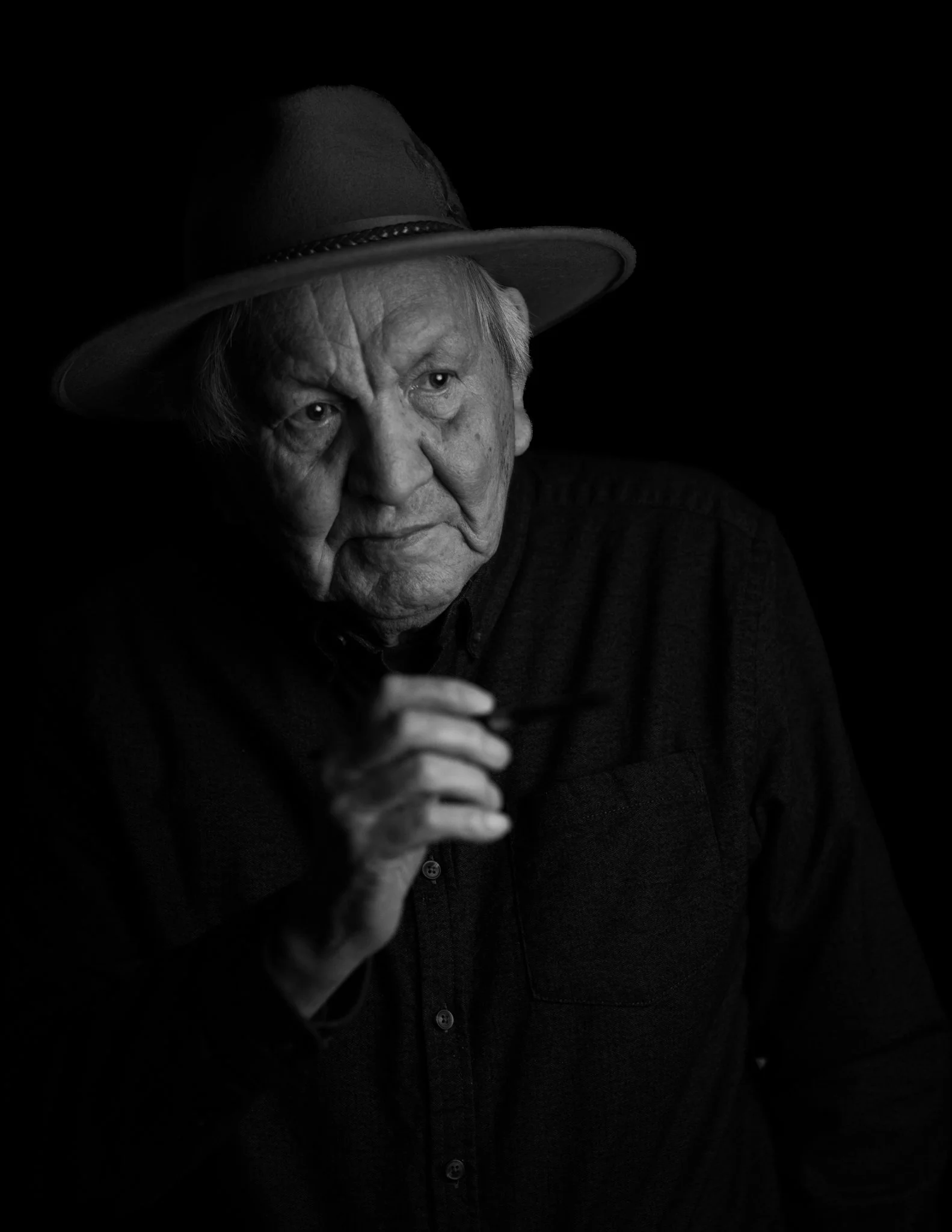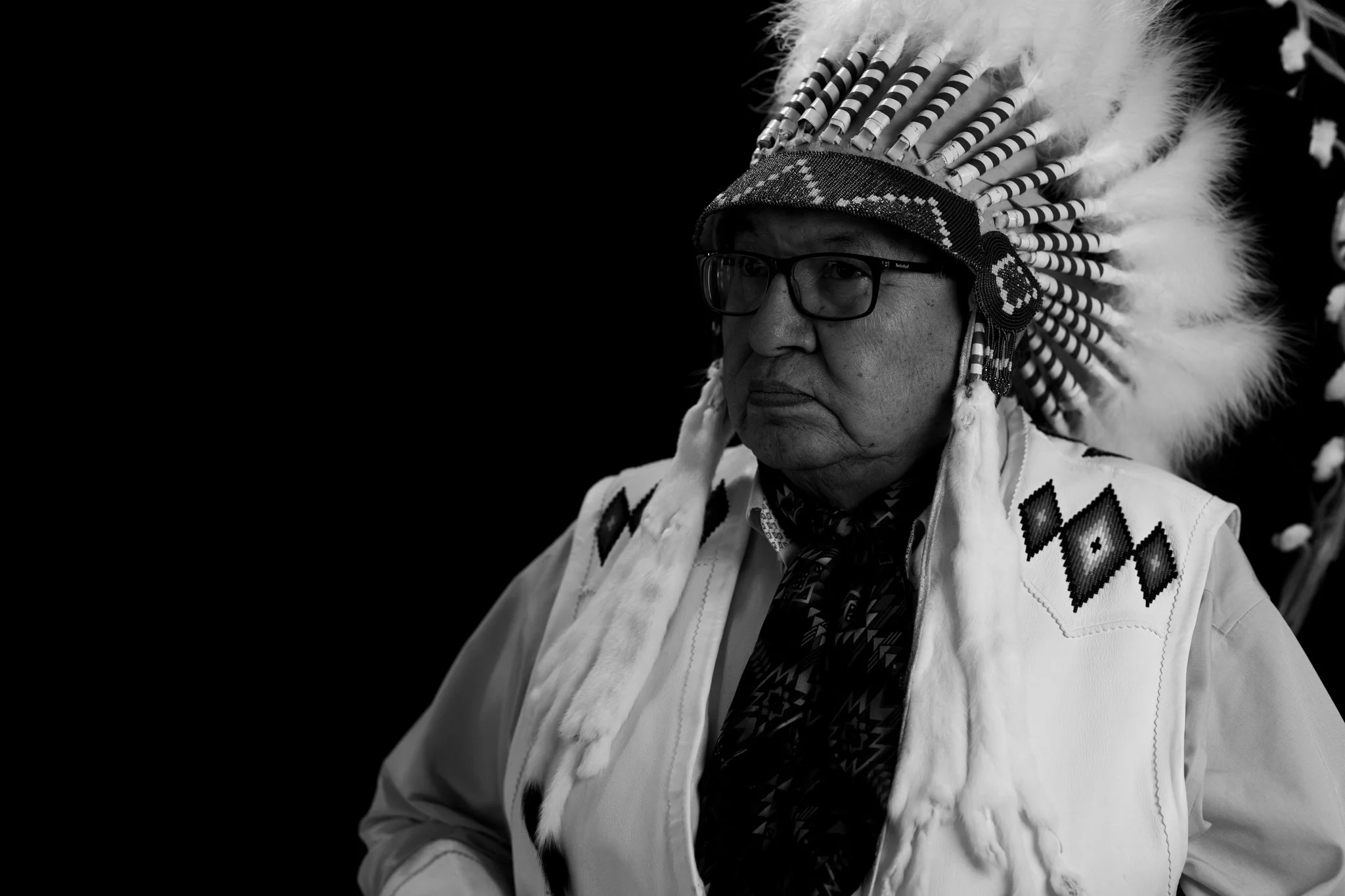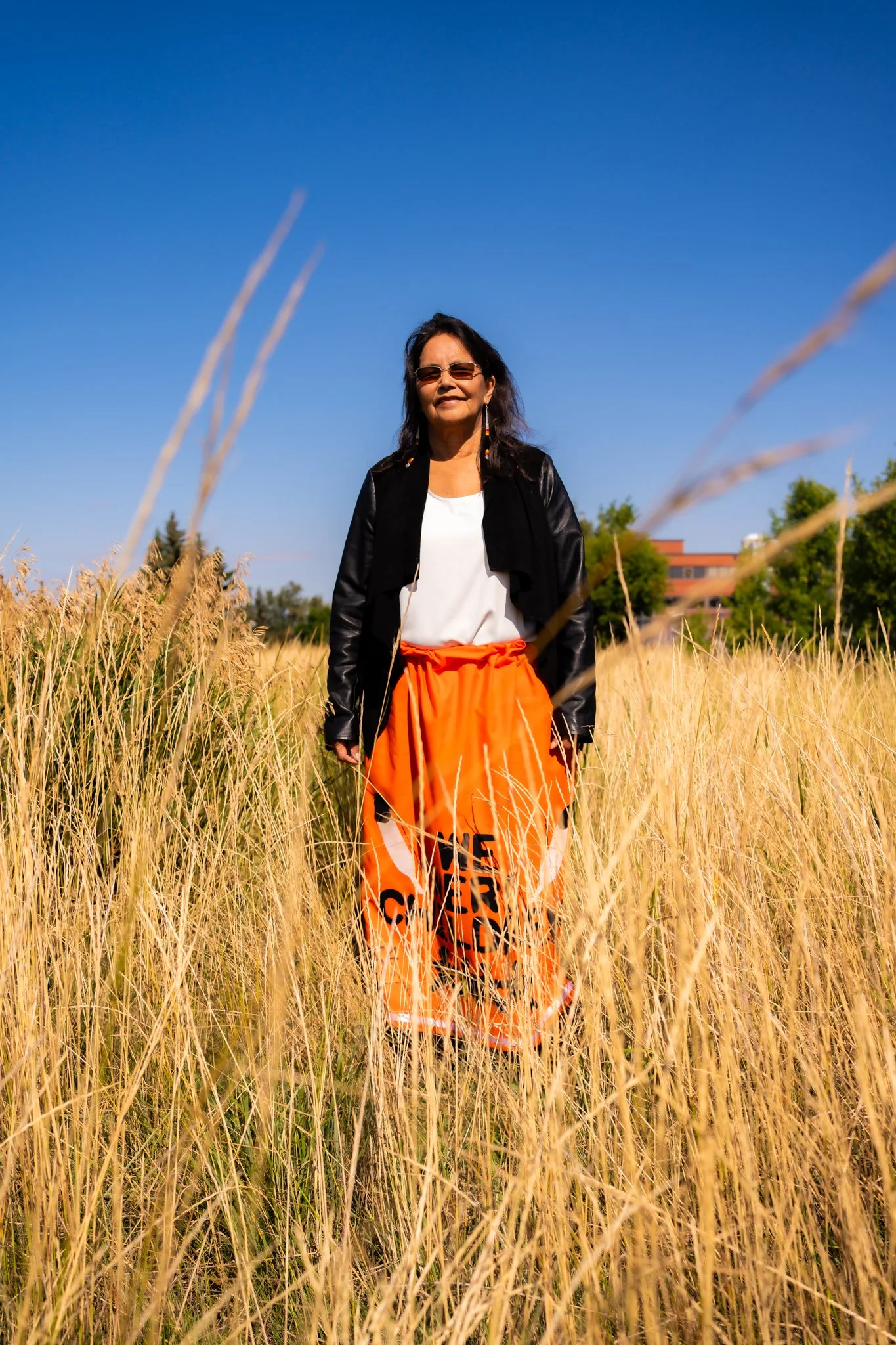
Survivor Portraits
Survivor Portraits is a gallery initially hosted by Kingsway Mall in Edmonton, Alberta that showcased Residential School Survivors and their stories.
The aim of the exhibit was to show non-Indigenous patrons that Residential Schools are not a part of Canada’s ancient history and that survivors are still with us, thriving, and contributing to their families, communities, and nations.
Below are each of the survivors and a summary of their stories for all to read.
Thank you to the Survivors for allowing us to hold space for their stories to be told.

Peggy Shannon originally from Haida Gwaii, she has three kids, and seven grandchildren, and four great-grandchildren. Peggy attended St. Michael’s Indian Residential School in Alert Bay, BC from the age of 6 until she was 14 years old. The trauma she endured while attending St. Michael’s has caused her to block those years from her mind. She recalls watching a nun beating another survivor so badly that everyone thought that child had been killed. Another memory she recalls is waking up on the roof of the residential school without any recollection on how she got up there; there was no physical way for her to get up there. Her main memory of attending St. Michael’s is she never left. While other survivors were able to leave during the summer months, her family was too far away for her to go to so she was forced to stay at the school for the full eight years.
Before Residential School, Peggy would play outside all day long with her friends and siblings, unbothered, only returning home when they all got hungry.
Today, Peggy is the matriarch of her family and has spent her life working with post-secondary students at Capilano College in North Vancouver. She has since retired and lives with her partner in North Van, lending her time as an Elder in the Greater Vancouver area. As part of her healing, Peggy drums and sings in her own dance group, she states that she brings her drum everywhere now because it’s something that the Residential Schools tried to take from her, so now she has it with her all the time.
What I wanted to say at the end too was I came down here to come to university twenty years ago. I had a Grade 9 education because as soon as I got out of that place, I didn’t go to school any more. I just drank. Then I came here. I went to Adult Basic Education and I didn’t figure I could even do that. Then I went on to do my Bachelor’s in 4 years and then I went on to do my Master’s in one year.”
Alex Janvier attended Blue Quills Indian Residential School in northern Alberta when he was nearly eight years old, and left 11 years later material when he turned 18. The education he received there was not on par with the standards of the day, he says it’s because the teachers were “not institutionalized to teach beyond grade eight.” Alex goes on to say that living in the Residential school was not easy because of the isolation and control exhibited by the nuns and priests that ran the schools: “We prayed a lot and everywhere we went we were always praying and this one (Blue Quills) was strict.” He goes on to say that church control was very strict in fact the whole thing was strict and that nobody should go through that kind of lifestyle.
Alex’s healing began when he returned to Blue Quills in an effort to understand what went on in that school. He hints at the unmarked graves that will inevitably be found on the school grounds, and that the healing in a lot of residential school survivors is “not there yet” but it's something we need to act on sooner than later. Residential schools dug deep into the lives of the survivors who attended them Alex says: “infringement into our lives is very deep, it attacked us for being native it's destroyed us through powerful religious effort.
Alex credits survivors with the great strength they’ve shown in overcoming their trauma, himself included. His own healing was through his art, for which he’s become world renowned for. Of all his accolades he’s received through his art, his primary concern has always been his family, and the Denesuline people. As long as his family is taken care of, Alex was happy.
Curator’s note: From when Alex and his family agreed to be included in my Survivor Portraits exhibit, they have been very open and welcomed Alex being included in this exhibit. Sadly, I must report Alex has passed on to the Spirit World before the exhibit opened. I thank the Janvier family for their love and support, and for allowing me to include this absolute legend of a human being in my exhibit. I hope to do right by him and all of you.
Hello my name is Faye Dillon-Wolfe, I live in Maskwacis Alberta, Ermineskin Cree Nation. Born in Paradise Hill, Saskatchewan. I am Plains Cree from Treaty 6 Territory.
My father is Peter John Wolfe, My Late mother is Rita Marie Wolfe. My Paternal Grandparents are Late Percy Lloyd Wolfe ekwa Late Edith Bernice (Minde) Samson & My Material Grandparents are Late Lloyd Dillon ekwa Late Julia (Ochipow) Dillon. My Fathers parents come from Maskwacis, Percy was from Ermineskin Cree Nation, Bernice was from Samson Cree Nation. Lloyd is from Onion Lake, Saskatchewan. Julia is from Thunderchild, Saskatchewan.
They all attend residential schools, except for my kokum Julia. She was blind as a child. She was raised and kept at home. We are the last generations of Residential School Survivor's.
I attended Ermineskin Kindergarten in 1988-89, 1989-91. The school in Maskwacis (formally known as Hobbema) Officially closed as a residential school in 1991.
"The Ermineskin Indian Residential School opened in 1894 and had an enrolment of 20 by the following year. In 1949, a day school opened with about 200 students. By 1980, Ermineskin was the largest Indian Residential School in Canada, with students from many other reserves in Alberta, Indian students from Saskatchewan, Métis students, and even some non-Aboriginal students. The student residence closed in 1975 with administration of the school being completely transferred to the Ermineskin Cree Nation by 1991."
Currently, I am a Class 1 Driver. I drive the bus for my community and four band nations in Maskwacis. I also work casually as an Educational Assistant for our community schools. I hold a Heavy Equipment Operators Certificate. I'm very passionate about Trades. I also have experience in Welding, Pipe fitting, and Millwright. I also want to be a Carpenter one day. I was an extra in "The Revenent" with Leonard Dicaprio (2015). I started modeling in 2021. Since then, I've traveled all over Turtle Island. I've attended numerous shows in Canada, and United States. As well as Internationally. I worked with over 35 Indigenous Designers. With a dream to work for as many, as possible.
I used to be ashamed of myself. I didn't ever think I'd get to travel to so many beautiful places. Places, I've only seen on T.V. Today I am proud of who I am. Where I came from. The color of my skin. My language. The way my nose looks. I'm proud to inspire the youth/children in my family & community. I'm breaking the intergenerational trauma, curses and abuse that I still feel lingering amongst us Indigenous descendants. I pray we all find healthy ways to cope & heal.
Ay Hai
My name is Charlie Fox. Piitonista or “Eagle Calf” is my Blackfoot name. That's the name that I got from the Elders who saw fit that I take my grandfather's name, who was quite immersed in our spiritual ways. I knew my grandfather a little bit, and he was a person that I emulated. I’m so very proud to carry his name. I grew up in Southern Alberta on the Blood reserve or Kainai nation, and pretty much lived there all my life. I went to residential school.
Being at residential school wasn't quite what I expected, you know, because when I was seven years old, I was able to write and know the alphabet and read a little bit. My sisters taught me and I really wanted to get a to go to school to learn more. But when I got there, I don't think it was 15 minutes after my parents dropped me off before the nuns dragged me upstairs and stripped me and cut my hair jabbing those dull clippers on my hair enough so they caused cuts into my scalp. And then I got a number and a bunch of marked clothes with that number. I enjoyed the school part of it, but other than that it was almost like the survival for the fittest. There were times where I thought I was going to die when we were put into a small 10 by 10 room with extreme steam. When everything started up, it sounded like a train coming at us. It was a horrific experience. Over the years you eventually learn how to survive, how to fight. The food was not very good.
But when I left, I never went back to the residential school. I had really loving parents and I had a lot of the older brothers and we I spent a lot of time being around horses and baling hay and branding and stuff like that. Being taught strong work ethics, you know. For me, I enjoyed the horsemanship part of it. And so that was my greatest passion was to be as good a horseman as I could. But really, my parents were the ones that really supported me with everything, going to the mountains. I especially enjoyed the mountains because my my father took us up there to cut rails, and we would spend a few days up there camping, those were really great times, you know, with family.
My name is Mavis Moberly and I’m from Treaty 8, a place called Salt River First Nation. I'm a grandmother and a great-grandmother. I'm a residential school survivor and I was I went into residential school in 1964, and I came out of there in 1968. The residential school I attended was the name is saint Henry's residential school.
My experience at the residential school I was 8 years old. So as a young child as a young girl and just having lost my mother that year, it was very, very difficult and because there was no nurturing, there was no comfort there was nothing like that. Instead, there was a lot of a lot of beatings and segregation, so there was a whole bunch of different things that I had experienced in that 4 years, even though the guns knew that my mother had passed away.
Despite that, they were very, very cold, and very it was just, it was just a cold place to be, and I kept thinking I was in a horrible nightmare that I was going to wake up and that I'd be at home with my parents, because I had 7 other siblings, 4 brothers and 3 sisters and my 4 brothers wasn't allowed to see because they were because they were boys and everyone. We were separated from them in the residential school so it was I got to see my sisters, which is good but so his separation, and I used to speak back then I spoke fluent Cree, and so when I went into the residential school it was we weren't allowed to I wasn't allowed to speak my language so, but if we A bird accidentally slipped without you know if I spoke a pre word it was, I'd be punished instantly, despite saying, oh I'm sorry or apologizing and stuff.
I'd be grab by the hair and take into the sink up and soap was put into my mouth, or I was strapped. Somehow, they found a way to punish me, you know, think looking like I did it on purpose, but when you're a child and you have your language and your culture, it's hard to you know being brought up from it from a baby right up until 8 years old, so, but there was a lot of punishment so I grew too. To slowly forget my language because I wasn't allowed to speak it.
And so it was constant tension involved like I was it was like I was awake 24/7, because I had to be careful even when I was sleeping. I was afraid that somehow some way I was gonna be, you know, there's gonna be some sort of punishment as there was with the other girls in the dorm and my number was 21. Everything was marked on my clothes and my My toothbrush, my comb, everything was number 21, that was my, that's how I would be called by not by my first name and so that numbers etched in my memory forever.
My name is Regan Valerie Gamble, and I'm from treaty six territory, Beardys and Okemasis First Nation in Saskatchewan. All I know is I was seven years old is when I was taken. I was taken from a foster home in Saskatoon, and I was brought to St Michael's Indian residential school in Duck Lake, Saskatchewan. I recognized the road, the highway, and I thought that I was going home to my kohkum’s in Beardy’s. Instead of going to Beardy’s, we turned off in town, where we were going, I was absolutely clueless. I just didn't know where we were going. And I was such a little girl. And I remember sitting in the back seat, and this car just seems so huge. Everything just seemed so big at the time and where, and we pull all I see is just a driveway, and on either side of the road there's nothing but trees, trees just like towering over like an arch.
It was sunny outside, so the sun is shining through the trees, the shade, and sun and shade and it just seemed like for such a long time, and then all at once, I look up, and then there's just this huge building. And then they opened the door for me to get out, and I was thinking, you know, this is not where I'm supposed to be, like, what's happening? And she just said, We're, you're just going be here for a little while. I just had no idea. And I remember that time, I didn't want to go, I don't want to go in there, and so she pulled me out of the car crying, and bring me up these stairs that just again, seemed to just last forever. And I'm so little, and I'm holding the handrail, and it's kind of like, by my shoulder, I'm just holding it, and I look up and I just see this huge statue at the very, very top of this building. And it's like, it's like, there was like a pitchfork or something in the statue, and it was just kind of pointed down. I'll never forget that image. And then next thing you know, I'm going inside and then they left.
I was sexually abused by two other girls, one was a lot older, and one seemed, you know, not very much older than I was. And so I was always afraid, always afraid to go to bed. I slept by the door the fire escape, and there's an exit sign on top of the door. There's a little red light that beeps. And I would just count that light forever and ever and ever, I would just count it, count it. Sometimes I would reach, like 1000 and some, sometimes I'd reach 5000 I would just count it, and then, and then I would be just waking up. Would be time to start another day.
I was there year after year after year after year. And sometimes I got to go to my kohkum’s. Sometimes I would go to my mom, I think, or unless it was all before, um. And then time went on and on and on and on and everything continued for the number of years that I was there. I was there for nine years in total. It took me a long time, 47 years is when I finally started to address my addiction, and I just finally gave everything. It's only been just over a year, for heaven's sakes, and I think if everything that I’ve learned in just this over a year, if I would have known this, you know, when I was younger, how different my life would have been, how different our lives would have been. I've got this profound there's something inside of me I really would love to dance as a child. It's something that I've always wanted to do, and so I really want to I really want to dance. I want to get more in touch with my culture and my traditions, with my language. I was never able to speak Cree, and I still can't. I feel so robbed. I'm such a proud, proud Cree woman, plains Cree woman so I need to learn. I need to empower myself, so learning my learning my dance, learning my language, learning more about medicine and ceremony, is so healing and it's so empowering. So that's what I want to do.






